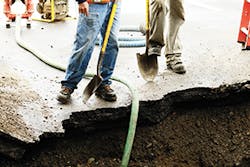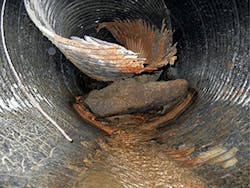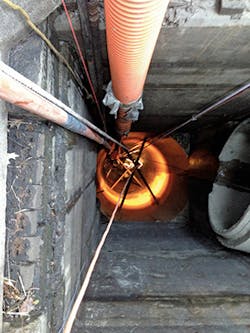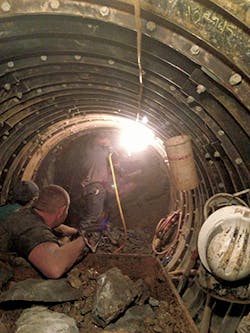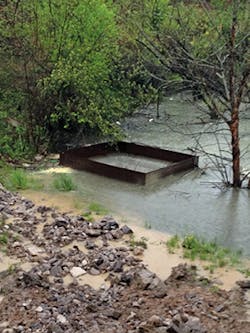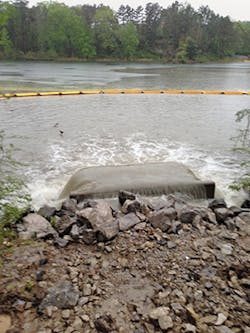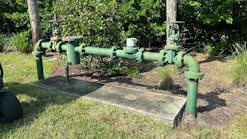With flooding, sinkholes, danger, and suspense, this story may resemble the latest Hollywood adventure film. However, it is the real-life saga of a stormwater pipe collapse on Birmingham, AL’s Highway 280 and a race against time along one of the state’s busiest roadways. Its dramatic narrative rivals any blockbuster action film.
Location Is Everything (Especially in Stormwater Management)
A collapse occurred in an upscale shopping area called The Summit. The 1-million-square-foot retail center opened in 1997 and is a luxury environment of manicured grounds and high-end stores. It also has more than 100 acres of impermeable surface—parking lots and roofs. Runoff from the site flows to a detention pond at the bottom slope of the shopping area.
Charles Malone, assistant area administrator of maintenance and a 40-year veteran of the Alabama Department of Transportation (DOT), describes the situation: “So here we have this nice, manicured grass area, beautiful flowers, trees, and landscaping, and we get a call one morning that there is suddenly a 40-foot sinkhole.”
In retrospect, Malone says he knows that the sinkhole didn’t happen overnight, but was the outcome of a series of events that were most likely progressing to disaster “for at least a few years.”
But at the time no one knew this, he explains.
“The detention pond has a concrete overflow pipe, and this connects with a junction box down in the pond. When the water level increases, it flows into the pipe and connects down into a corrugated pipe system that is 65 feet underground and passes under Highway 280,” says Malone.
The six-lane, divided highway that interchanges with Interstate 459 near The Summit makes it one of the busiest arteries in the state. But because of the elevation of the shopping center, the stormwater system at The Summit collects runoff and then drops 65 vertical feet underground, connecting to the transverse pipe under the road that exits almost 500 feet away into a receiving lake that is situated on an AT&T corporate campus.
This design makes it a closed system on both ends, which Malone says does not allow for routine inspections because there is no way to get in at either point. And inaccessibility keeps problems concealed and undetected.
Malone speculates that the pipe collapse had already occurred much earlier than the development of the sinkhole. He surmises that when the detention pond experienced previous flooding and required repair a few months earlier, it was probably an early warning that a much more severe problem was developing underground.
“While it was in this stage of being partially collapsed, it was pulling materials down from the top, and we think this was creating a kind of cavern effect up on the surface. You didn’t notice it to start, but eventually with enough material falling away underneath, it finally collapsed from the top, then sunk down 10 to 15 feet and grew to 40 feet in diameter, and then this started filling up with stormwater because it couldn’t go anywhere else.”
But he says the deterioration created significant impact.
“After 30 or 40 years, that pipe was rusted and corroded, and the weight of the overburden caused it to collapse. It wasn’t just dirt, but rocks and boulders from the fill material,” which had created an urgent situation. The corrugated metal pipe was likely made of galvanized steel, as it was the standard coating of that time. Since then, several premium coatings have been developed that provide 75 years or more of service life.
But while this flooding sinkhole got everyone’s attention, it offered no clue as to the true extent of the damage. Malone immediately called upon Video Industrial Services Inc., which had assisted the DOT in another high-profile shopping area, to enlist the company’s help and assess the full scope of the damage.
The Painful Process of Discovery
Rodney Blackmon, executive vice-president and general manager of Video Industrial Services, says the company’s reputation and range of services for “tough projects like this” made it well-prepared to diagnose and help fix the stormwater system damage at The Summit.
Video Industrial is an affiliate of Carylon Corp., a Chicago-based company that specializes in multiple maintenance services to help municipalities, utilities, and industries with environmental compliance. The company has assisted local efforts to manage disastrous events such as the flooding of the Chicago Loop from a breached underground tunnel, numerous floods and hurricanes across the Gulf Coast, and cleanup at the 9/11 World Trade Center disaster, among others.
“We do all kinds of cleaning, dewatering, and sludge removal, and our video inspection services in this case were absolutely key to the cleanup and repair strategies of the pipe collapse,” says Blackmon. “When we were first called by Charles Malone at the Alabama
DOT, we thought it was a sewer line that had washed out part of a pipe. We thought that eventually the pressure pushed the pipe in, and when that fell in, it sealed up the pipe. Naturally, the pond would start filling up.”
He says the first step prior to any camera inspection was to gain access to the pipe system. Crews pumped water from the sinkhole on the Summit side, but soon after that there was a massive rainstorm.
“We had our little pump going, and it wouldn’t touch that amount of water,” he says.
“At this point Malone was trying to get contractors lined up, because he knew that the sewer had collapsed. This new storm came in and washed out part of the detention pond’s earthen dam, and it flushed huge rocks and debris out, which ended up closing one of the roadway exits. If the whole dam had washed away it would have hit the highway and pushed cars off into the ravine. In just a couple of hours it was overflowing like crazy,” says Blackmon.
However, no work strategy could be planned until the video inspection assessed the entire system, which by necessity had to be done in piecemeal efforts as obstructions had to be cleared in stages.
The old pipe had collapsed and twisted.
Getting the Real Picture of Problems
This process was literally an eye-opener to the extent of the problem. Philip Bell, division manager at Video Industrial Services, describes the view when crews examined the outflow on the AT&T end.
“A lot of rocks had come down the pipe,” he says. “When we got into the storm pipe, it was 80% full and blocked at the outfall. There was a very small air gap.”
He explains that typically crews can use high-pressure water-jetting equipment to clear away water
and debris. “These machines are designed to flush out a manhole then extract the water and debris, but we couldn’t do that here because we couldn’t disturb the lake water on the AT&T side, since it’s used for chiller water. We could not create any turbidity, which further restricted our efforts.”
The company instead used industrial vacuum trucks. “We moved yards of material,” says Bell. “We would normally take these very large rocks out in the day and the smaller stuff at night. We were working day and night and we had to be careful to not scratch any of the property trees on the AT&T side, although we did have to take a few down.”
Crews put the camera in as far as they could, but after a few hundred feet the space was too small to go farther, so the next stage involved pumping down the upper inlet, putting the camera on a float, and pushing it in downstream.
Looking down into the 72-inchdiameter stand pipe at The Summit
“Right past the junction pipe there was a big, twisted piece of corrugated storm pipe that was up inside the line. It had elongated, curled up, and was wedged in place,” says Bell. He adds that the pipe had stopped 150 feet from where it had come loose.
Removing this source of the problem was essential to any further work, so after cleaning around the pipe to free it up, crews burned holes into the metal, put in a clevis, and pulled it free and out of the line using a powerful winch.
“You can’t hurry in a situation like this,” says Bell. “We were mindful of the timetable, but you can’t put people in jeopardy. We talked to our company president to advise him what we were doing, and his advice in this—and any project—was ‘None of us is as smart as all of us,’ and he’s right; you need a lot a lot brains to weigh every possible hazard. We were very fortunate in that no one was hurt, but we do everything we can to minimize those risks.”
In the meantime, all work being done was subjecting the workers to water, and keeping the pond pumped down was essential to keep them safe from the hydraulic pressure of the groundwater and stormwater. Malone says they had access to a ditch, so the pumps took the water out of the pond and carried it down to a safe level.
Throughout this initial cleanup, says Malone, his other priority was “to keep the road safe.”
He says, “We got an emergency authorization letter signed by the state transportation board, which allowed us to seek bids for repairs.” The Russo Corp. was awarded the project. The firm serves southeastern states from Arizona to North Carolina and specializes in site work, foundation drilling, injection technologies, and underground utilities.
And Now the Real Fun Begins
Jake Brown, project manager from the Birmingham office of Russo Corp., cites some figures that could quickly have created a hazardous situation for workers and compromised the work timetable. “When you have 100 acres of hard space [generating] stormwater runoff, as we did, a one-inch rainfall translates to 2.72 million gallons of stormwater.”
He explains that runoff from The Summit shopping mall drains into the detention pond in front of the property. When the detention pond reaches a certain level, it overflows into an outlet pipe that flows horizontally over to the standpipe, the 72-inch-diameter vertical shaft that drops down 65 feet and joins with a horizontal pipeline that then carries the water underneath Highway 280 and into the lake at the AT&T site.
liner plates
With safety as the utmost priority and before any work was done, says Brown, crews built and installed a plug that was attached inside the 72-inch vertical pipe about 15 feet below the surface.
“This plug was essential to keep water away from our workers and keep them safe, and we also had a 65-foot vertical pipe attached so we could continuously pump water out as well.”
With the plug in place, the workers could enter at the outfall side and walk up to their work area.
Nonetheless, Brown says, “The rule was, ‘the minute it starts raining, everyone must leave the pipe immediately.'”
He notes, “Our plan was to go in and hand-tunnel through the collapsed section of pipe, which in this case had to be done like a mining operation.”
He describes the track they installed within the pipe as similar to those used in a mining operation, operated via a winch system. “This pulled a buggy in and out with the debris that was hand-loaded from the inside of the pipeline.” The material was removed in order to replace the existing failed pipe with 72-inch-diameter tunnel liner plates.
Russo selected tunnel liner plates manufactured by Contech Engineered Solutions. With a broad variety of pipe and pipe liner products, Contech specializes in helping engineers, architects, and owners find the correct engineered solution for drainage, erosion control, stormwater, sanitary, and wastewater treatment projects across the country. For this project, metal tunnel liner plates that come in five pieces (each 18 inches wide) were used. These sections were brought in and then bolted together right over the existing pipe to create a new lining. The sectional approach was necessary to allow the workers a protected area under which to work.
Brown says Contech engineers the plates with pre-drilled holes so that grout can be injected to fill any exterior voids around the new liner that would have been created by the excavation required to install the liner plates.
It was a slow and precarious process, as the workers entered from the AT&T property and went more than 350 feet underground from the cleared area to begin the liner plate installation. The contractor had hung lighting and had fresh air continuously blown into the space.
Malone recalls the claustrophobic sensation of being inside the pipe. “When you looked back to the outlet, it looked like the diameter of a pencil. Plus you’re going uphill and you’re still fighting the infiltration of groundwater. Not everybody could do this job.”
Before the installation of the tunnel liner plates, says Brown, crews used their drilling and grouting capabilities to drill 65 feet down, at an angle, from the outside surface to inject compaction grout around the failed section of pipe to provide safety for the installation of the liner plates. “We basically created a dome of grout around the work area.”
Malone adds, “This was a really smart thing to do, as this fills in the voids and the earth overburden.” Stabilizing the area allows the debris removal to be done in sections. “You couldn’t remove it all at one time because it would cave in.”
Once the workers had the liner in place, they could then remove any additional debris, allowing them to go forward and build another ring.
“You need one full 18-inch-long, 72-inch-diameter ring installed to start the tunnel, and that provides the safety to continue installing additional liner plates.” This is a “one way in, one way out situation,” says Brown, but once crews got started, they got yet another surprise.
“We were contracted to replace a 20-foot section of the existing horizontal 66-inch pipe, and a separate three-foot section of the same existing 66-inch pipe where it tied into the 72-inch vertical stand pipe, for a total of 23 feet. We completed the 20-foot section, and then proceeded to repair the three-foot section that had settled at the point of connection to the standpipe. However, the existing pipe between the newly installed liner plates and the three-foot section of settled pipe was in bad shape, with numerous cracks and chips throughout. Therefore, because of safety concerns with this deteriorated portion of pipe, the decision was made to replace the remainder of the pipe with additional tunnel liner plates. So we had to go back to square one to address this.”
In the end, says Brown, the initial 23-foot repair of the pipeline more than quadrupled, and workers ended up installing 85 feet of 72-inch-diameter tunnel liner plates.
After this process was completed, the final piece of the project involved relining the entire 487-foot-long horizontal pipe with CentriPipe, a centrifugally cast concrete pipe liner system from AP/M Permaform. In this case Permacast PL-8,000 pipe liner was used, a high-strength, abrasion-resistant and corrosion-resistant mortar. A specific benefit of Permacast is its high adhesion properties and its ability to stick to any surface.
Brown says the relining process is done with a SpinCaster unit that has variable speed and rotates as it coats the surfaces of pipe. It is retrieved by the operator once the coating is cast evenly around the pipe interior.
“We had to make several passes, the first one was just to fill up the corrugations in the pipe, and then we went back and did several more passes to build up to a uniform two-inch thickness the entire length of the pipeline.” CentriPipe components leach no harmful chemicals, and this is the only lining material that has passed the stringent testing of the New York Department of Transportation for lining culverts. The company says that CentriPipe has a very low Coulomb rating and does not allow sodium chloride ions to pass through, which is especially important in regions where salt is used for road deicing.
Brown likes the way the product performs. “One of the benefits is that it’s a standalone. If you didn’t use the liner plates, and applied it in thickness, everything behind it can fail, but this product holds up structurally. Over the years steel can corrode, but this stuff lasts.”
The work’s end result is the extended lifespan of The Summit’s stormwater system. Ensuring highway safety is also Malone’s priority.
“We weren’t expecting this. It was a very unique situation, a closed system with no way to get in and make inspections; nobody suspected there were problems. Our resources with Video Industrial Services and Russo were excellent, and I was very happy with the way they were able to solve a huge set of problems, as we don’t have those internal state resources. They were out there 24/7 keeping the road safe and ensuring public safety, which is a big concern.”
Focusing on a Fly
Philip Bell describes the cutting-edge technology that his team at Video Industrial Services uses as “miniature cameras that are on 2,000-foot cables that can pan, tilt, circle around, and almost look behind it. These new cameras are so sophisticated, you can remotely focus in on a fly, and the new external LED lighting make it so much brighter, you get a much better picture now.”
From a remote truck, he says, a video operator guides the unit, which can be on small wheels about the size of child’s toy wagon, or can be put on a float in a water scenario. The video operator can then stop the camera, focus, and capture important screenshots at nearly any angle.
The technology is light years from where it was just a few years ago, he says, and these units give accurate, low-intervention assessments of problems, accessing areas too challenging or dangerous for people to attempt.
The old pipe had collapsed and twisted.
To access additional case studies and in-depth reporting, check out the May edition of Water Efficiency.
You may need to log-in or subscribe to our magazine.
